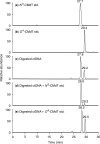Chemical synthesis of oligodeoxyribonucleotides containing N3- and O4-carboxymethylthymidine and their formation in DNA
- PMID: 19042973
- PMCID: PMC2632895
- DOI: 10.1093/nar/gkn946
Chemical synthesis of oligodeoxyribonucleotides containing N3- and O4-carboxymethylthymidine and their formation in DNA
Abstract
Humans are exposed to N-nitroso compounds from both endogenous and exogenous sources. Many N-nitroso compounds can be metabolically activated to give diazoacetate, which can result in the carboxymethylation of DNA. The remarkable similarity in p53 mutations found in human gastrointestinal tumors and in shuttle vector studies, where the human p53 gene-containing vector was treated with diazoacetate and propagated in yeast cells, suggests that diazoacetate might be an important etiological agent for human gastrointestinal tumors. The O(6)-carboxymethyl-2'-deoxyguanosine was previously detected in isolated DNA upon exposure to diazoacetate and in blood samples of healthy human subjects. The corresponding modifications of thymidine and 2'-deoxyadenosine have not been assessed, though significant mutations at A:T base pairs were found in the p53 tumor suppressor gene in human gastrointestinal tumors and in shuttle vector studies. To understand the implications of the carboxymethylation chemistry of thymidine in the observed mutations at A:T base pairs, here we synthesized authentic N3-carboxymethylthymidine (N3-CMdT) and O(4)-carboxymethylthymidine (O(4)-CMdT), incorporated them into DNA, and demonstrated, for the first time, that they were the major carboxymethylated derivatives of thymidine formed in calf thymus DNA upon exposure to diazoacetate. The demonstration of the formation of N3-CMdT and O(4)-CMdT in isolated DNA upon treatment with diazoacetate, together with the preparation of authentic oligodeoxyribonucleotide substrates housing these two lesions, laid the foundation for investigating the replication and repair of these lesions and for understanding their implications in the mutations observed in human gastrointestinal tumors.
Figures







Similar articles
-
Replication studies of carboxymethylated DNA lesions in human cells.Nucleic Acids Res. 2017 Jul 7;45(12):7276-7284. doi: 10.1093/nar/gkx442. Nucleic Acids Res. 2017. PMID: 28531304 Free PMC article.
-
Transcriptional inhibition and mutagenesis induced by N-nitroso compound-derived carboxymethylated thymidine adducts in DNA.Nucleic Acids Res. 2015 Jan;43(2):1012-8. doi: 10.1093/nar/gku1391. Epub 2015 Jan 8. Nucleic Acids Res. 2015. PMID: 25572317 Free PMC article.
-
In vitro replication studies of carboxymethylated DNA lesions with Saccharomyces cerevisiae polymerase η.Biochemistry. 2011 Sep 6;50(35):7666-73. doi: 10.1021/bi2007417. Epub 2011 Aug 11. Biochemistry. 2011. PMID: 21809836 Free PMC article.
-
Repair and replication of oxidized DNA bases using modified oligodeoxyribonucleotides.Biochimie. 2000 Jan;82(1):19-24. doi: 10.1016/s0300-9084(00)00347-3. Biochimie. 2000. PMID: 10717382 Review.
-
Why do O6-alkylguanine and O4-alkylthymine miscode? The relationship between the structure of DNA containing O6-alkylguanine and O4-alkylthymine and the mutagenic properties of these bases.Mutat Res. 1990 Nov-Dec;233(1-2):81-94. doi: 10.1016/0027-5107(90)90153-u. Mutat Res. 1990. PMID: 2233815 Review.
Cited by
-
Quantitative measurement of transcriptional inhibition and mutagenesis induced by site-specifically incorporated DNA lesions in vitro and in vivo.Nat Protoc. 2015 Sep;10(9):1389-406. doi: 10.1038/nprot.2015.094. Epub 2015 Aug 20. Nat Protoc. 2015. PMID: 26292071 Free PMC article.
-
Roles of Aag, Alkbh2, and Alkbh3 in the Repair of Carboxymethylated and Ethylated Thymidine Lesions.ACS Chem Biol. 2016 May 20;11(5):1332-8. doi: 10.1021/acschembio.6b00085. Epub 2016 Mar 4. ACS Chem Biol. 2016. PMID: 26930515 Free PMC article.
-
Molecular dynamics simulation analysis of the beta amyloid peptide with docked inhibitors.Bioinformation. 2022 Jul 31;18(7):622-629. doi: 10.6026/97320630018622. eCollection 2022. Bioinformation. 2022. PMID: 37313055 Free PMC article.
-
Quantification of Azaserine-Induced Carboxymethylated and Methylated DNA Lesions in Cells by Nanoflow Liquid Chromatography-Nanoelectrospray Ionization Tandem Mass Spectrometry Coupled with the Stable Isotope-Dilution Method.Anal Chem. 2016 Aug 16;88(16):8036-42. doi: 10.1021/acs.analchem.6b01349. Epub 2016 Aug 2. Anal Chem. 2016. PMID: 27441891 Free PMC article.
-
Replication studies of carboxymethylated DNA lesions in human cells.Nucleic Acids Res. 2017 Jul 7;45(12):7276-7284. doi: 10.1093/nar/gkx442. Nucleic Acids Res. 2017. PMID: 28531304 Free PMC article.
References
-
- Tricker AR. N-nitroso compounds and man: sources of exposure, endogenous formation and occurrence in body fluids. Eur. J. Cancer Prev. 1997;6:226–268. - PubMed
-
- Jakszyn P, Bingham S, Pera G, Agudo A, Luben R, Welch A, Boeing H, Del Giudice G, Palli D, Saieva C, et al. Endogenous versus exogenous exposure to N-nitroso compounds and gastric cancer risk in the European Prospective Investigation into Cancer and Nutrition (EPIC-EURGAST) study. Carcinogenesis. 2006;27:1497–1501. - PubMed
-
- Busby WF, Jr, Shuker DE, Charnley G, Newberne PM, Tannenbaum SR, Wogan GN. Carcinogenicity in rats of the nitrosated bile acid conjugates N-nitrosoglycocholic acid and N-nitrosotaurocholic acid. Cancer Res. 1985;45:1367–1371. - PubMed
-
- Puju S, Shuker DE, Bishop WW, Falchuk KR, Tannenbaum SR, Thilly WG. Mutagenicity of N-nitroso bile acid conjugates in Salmonella typhimurium and diploid human lymphoblasts. Cancer Res. 1982;42:2601–2604. - PubMed
-
- Shuker DEG, Tannenbaum SR, Wishnok JS. N-nitroso bile acid conjugates. 1. Synthesis, chemical reactivity and mutagenic activity. J. Org. Chem. 1981;46:2092–2096.
Publication types
MeSH terms
Substances
Grants and funding
LinkOut - more resources
Full Text Sources
Molecular Biology Databases
Research Materials
Miscellaneous

